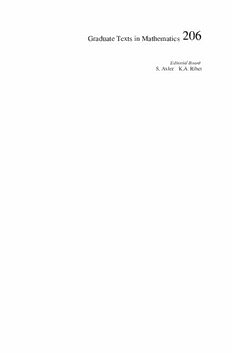
Problems in Analytic Number Theory PDF
Preview Problems in Analytic Number Theory
206 Graduate Texts in Mathematics EditorialBoard S.Axler K.A.Ribet GraduateTextsinMathematics 1 TAKEUTI/ZARING.Introductionto 36 KELLEY/NAMIOKAetal.Linear AxiomaticSetTheory.2nded. TopologicalSpaces. 2 OXTOBY.MeasureandCategory.2nded. 37 MONK.MathematicalLogic. 3 SCHAEFER.TopologicalVectorSpaces. 38 GRAUERT/FRITZSCHE.SeveralComplex 2nded. Variables. 4 HILTON/STAMMBACH.ACoursein 39 ARVESON.AnInvitationtoC-Algebras. HomologicalAlgebra.2nded. 40 KEMENY/SNELL/KNAPP.Denumerable 5 MACLANE.CategoriesfortheWorking MarkovChains.2nded. Mathematician.2nded. 41 APOSTOL.ModularFunctionsand 6 HUGHES/PIPER.ProjectivePlanes. DirichletSeriesinNumberTheory.2nded. 7 J.-P.Serre.ACourseinArithmetic. 42 J.-P.SERRE.LinearRepresentationsof 8 TAKEUTI/ZARING.AxiomaticSetTheory. FiniteGroups. 9 HUMPHREYS.IntroductiontoLie 43 GILLMAN/JERISON.RingsofContinuous AlgebrasandRepresentationTheory. Functions. 10 COHEN.ACourseinSimpleHomotopy 44 KENDIG.ElementaryAlgebraicGeometry. Theory. 45 LOE`ve.ProbabilityTheoryI.4thed. 11 CONWAY.FunctionsofOneComplex 46 LOE`ve.ProbabilityTheoryII.4thed. VariableI.2nded. 47 MOISE.GeometricTopologyin 12 BEALS.AdvancedMathematicalAnalysis. Dimensions2and3. 13 ANDERSON/FULLER.Ringsand 48 SACHS/WU.GeneralRelativityfor CategoriesofModules.2nded. Mathematicians. 14 GOLUBITSKY/GUILLEMIN.Stable 49 GRUENBERG/WEIR.LinearGeometry. MappingsandTheirSingularities. 2nded. 15 BERBERIAN.LecturesinFunctional 50 EDWARDS.Fermat’sLastTheorem. AnalysisandOperatorTheory. 51 KLINGENBERG.ACourseinDifferential 16 WINTER.TheStructureofFields. Geometry. 17 ROSENBLATT.RandomProcesses.2nded. 52 HARTSHORNE.AlgebraicGeometry. 18 HALMOS.MeasureTheory. 53 MANIN.ACourseinMathematicalLogic. 19 HALMOS.AHilbertSpaceProblemBook. 54 GRAVER/WATKINS.Combinatoricswith 2nded. EmphasisontheTheoryofGraphs. 20 HUSEMOLLER.FibreBundles.3rded. 55 BROWN/PEARCY.Introductionto 21 HUMPHREYS.LinearAlgebraicGroups. OperatorTheoryI:ElementsofFunctional 22 BARNES/MACK.AnAlgebraic Analysis. IntroductiontoMathematicalLogic. 56 MASSEY.AlgebraicTopology:An 23 GREUB.LinearAlgebra.4thed. Introduction. 24 HOLMES.GeometricFunctionalAnalysis 57 CROWELL/FOX.IntroductiontoKnot andItsApplications. Theory. 25 HEWITT/STROMBERG.RealandAbstract 58 KOBLITZ.p-adicNumbers,p-adic Analysis. Analysis,andZeta-Functions.2nded. 26 MANES.AlgebraicTheories. 59 LANG.CyclotomicFields. 27 KELLEY.GeneralTopology. 60 ARNOLD.MathematicalMethodsin 28 ZARISKI/SAMUEL.CommutativeAlgebra. ClassicalMechanics.2nded. Vol.I. 61 WHITEHEAD.ElementsofHomotopy 29 ZARISKI/SAMUEL.CommutativeAlgebra. Theory. Vol.II. 62 KARGAPOLOV/MERIZJAKOV. 30 JACOBSON.LecturesinAbstractAlgebra FundamentalsoftheTheoryofGroups. I.BasicConcepts. 63 BOLLOBAS.GraphTheory. 31 JACOBSON.LecturesinAbstract 64 EDWARDS.FourierSeries.Vol.I.2nded. AlgebraII.LinearAlgebra. 65 WELLS.DifferentialAnalysisonComplex 32 JACOBSON.LecturesinAbstractAlgebra Manifolds.2nded. III.TheoryofFieldsandGaloisTheory. 66 WATERHOUSE.IntroductiontoAffine 33 HIRSCH.DifferentialTopology. GroupSchemes. 34 SPITZER.PrinciplesofRandomWalk. 67 SERRE.LocalFields. 2nded. 68 WEIDMANN.LinearOperatorsinHilbert 35 ALEXANDER/WERMER.SeveralComplex Spaces. VariablesandBanachAlgebras.3rded. 69 LANG.CyclotomicFieldsII. (continuedafterindex) M. Ram Murty Problems in Analytic Number Theory Second Edition (cid:65)(cid:66)(cid:67) M.RamMurty DepartmentofMathematics&Statistics Queen’sUniversity 99UniversityAvenue KingstonONK7L3N6 Canada [email protected] EditorialBoard S.Axler K.A.Ribet MathematicsDepartment MathematicsDepartment SanFranciscoStateUniversity UniversityofCalifornia,Berkeley SanFrancisco,CA94132 Berkeley,CA94720-3840 USA USA ISBN978-0-387-72349-5 e-ISBN978-0-387-72350-1 DOI:10.1007/978-0-387-72350-1 LibraryofCongressControlNumber:2007940479 (cid:176)c2008SpringerScience+BusinessMedia,LLC Allrightsreserved.Thisworkmaynotbetranslatedorcopiedinwholeorinpartwithoutthewritten permissionofthepublisher(SpringerScience+BusinessMedia,LLC,233SpringStreet,NewYork, NY10013,USA),exceptforbriefexcerptsinconnectionwithreviewsorscholarlyanalysis.Use inconnectionwithanyformofinformationstorageandretrieval,electronicadaptation,computer software,orbysimilarordissimilarmethodologynowknownorhereafterdevelopedisforbidden. Theuseinthispublicationoftradenames,trademarks,servicemarks,andsimilarterms,evenifthey arenotidentifiedassuch,isnottobetakenasanexpressionofopinionastowhetherornottheyare subjecttoproprietaryrights. Printedonacid-freepaper 9 8 7 6 5 4 3 2 1 springer.com Likefireinapieceofflint,knowledgeexistsinthemind. Suggestionisthefrictionwhichbringsitout. Vivekananda Preface to the Second Edition This expanded and corrected second edition has a new chapter on the important topic of equidistribution. Undoubtedly, one cannot giveanexhaustivetreatmentofthesubjectinashortchapter.How- ever,wehopethattheproblemspresentedhereareenticingthatthe studentwillpursuefurtherandlearnfromothersources. A problem style presentation of the fundamental topics of ana- lyticnumbertheoryhasitsvirtues,asIhaveheardfromthosewho benefitedfromthefirstedition.Meretheoreticalknowledgeinany fieldisinsufficientforafullappreciationofthesubjectandoneof- ten needs to grapple with concrete questions in which these ideas areusedinavitalway.Knowledgeandthevariouslayersof“know- ing” are difficult to define or describe. However, one learns much and gains insight only through practice. Making mistakes is an in- tegral part of learning. Indeed, “it is practice first and knowledge afterwards.” Kingston,Ontario,Canada,September2007 M.RamMurty Acknowledgments for the Second Edition I would like to thank several people who have assisted me in correcting and expanding the first edition. They are Amir Akbary, Robin Chapman, Keith Conrad, Chantal David, Brandon Fodden, Sanoli Gun, Wentang Kuo, Yu-Ru Liu, Kumar Murty, Purusottam RathandMichaelRubinstein. Kingston,Ontario,Canada,September2007 M.RamMurty Preface to the First Edition “In order to become proficient in mathematics, or in any subject,” writes Andre´ Weil, “the student must realize that most topics in- volveonlyasmallnumberofbasicideas.”Afterlearningthesebasic concepts and theorems, the student should “drill in routine exer- cises, by which the necessary reflexes in handling such concepts maybeacquired....Therecanbenorealunderstandingofthebasic conceptsofamathematicaltheorywithoutanabilitytousethemin- telligently and apply them to specific problems.” Weil’s insightful observation becomes especially important at the graduate and re- searchlevel.Itistheviewpointofthisbook.Ourgoalistoacquaint thestudentwiththemethodsofanalyticnumbertheoryasrapidly aspossiblethroughexamplesandexercises. Any landmark theorem opens up a method of attacking other problems.Unlessthestudentisabletosiftoutfromthemassofthe- ory the underlying techniques, his or her understanding will only be academic and not that of a participant in research. The prime number theorem has given rise to the rich Tauberian theory and a generalmethodofDirichletserieswithwhichonecanstudytheas- ymptotics of sequences. It has also motivated the development of sieve methods. We focus on this theme in the book. We also touch upontheemergingSelbergtheory(inChapter8)andp-adicanalytic numbertheory(inChapter10). xii Preface This book is a collection of about five hundred problems in ana- lyticnumbertheorywiththesingularpurposeoftrainingthebegin- ninggraduatestudentinsomeofitssignificanttechniques.Assuch, it is expected that the student has had at least a semester course in each of real and complex analysis. The problems have been orga- nizedwiththepurposeofself-instruction.Thosewhoexercisetheir mental muscles by grappling with these problems on a daily basis will develop not only a knowledge of analytic number theory but also the discipline needed for self-instruction, which is indispens- ableattheresearchlevel. The book is ideal for a first course in analytic number theory ei- ther at the senior undergraduate level or the graduate level. There are several ways to give such a course. An introductory course at the senior undergraduate level can focus on chapters 1, 2, 3, 9, and 10. A beginning graduate course can in addition cover chapters 4, 5,and8.Anintensegraduatecoursecaneasilycovertheentiretext in one semester, relegating some of the routine chapters such as chapters6,7,and10tostudentpresentations.Oronecantakeupa chapteraweekduringasemestercoursewiththeinstructorfocus- ingonthemaintheoremsandillustratingthemwithafewworked examples. In the course of training students for graduate research, I found it tedious to keep repeating the cyclic pattern of courses in ana- lytic and algebraic number theory. This book, along with my other book“ProblemsinAlgebraicNumberTheory”(writtenjointlywith J.Esmonde),whichappearsasGraduateTextsinMathematics,Vol. 190, are intended to enable the student gain a quick initiation into the beautiful subject of number theory. No doubt, many important topics have been left out. Nevertheless, the material included here isa“basictoolkit”forthenumbertheoristandsomeoftheharder exercisesrevealthesubtle“tricksofthetrade.” Unless the mind is challenged, it does not perform. The student is therefore advised to work through the questions with some at- tention to the time factor. “Work expands to fill the time allotted toit”andsoifnoupperlimitisassigned,theminddoesnotgetfo- cused.Thereisnouniversalruleonhowlongoneshouldworkona problem.However,itisawell-knownfactthatself-discipline,what- evershapeitmaytake,opensthedoorforinspiration.Ifthemental muscles are exercised in this fashion, the nuances of the solution Preface xiii become clearer and significant. In this way, it is hoped that many, whodonothaveaccesstoan“externalteacher”willbenefitbythe approachofthistextandawakentheir“internalteacher.” Princeton,November1999 M.RamMurty
